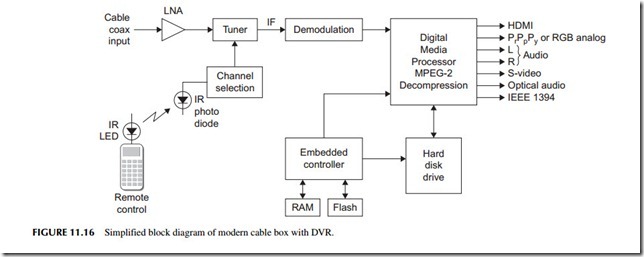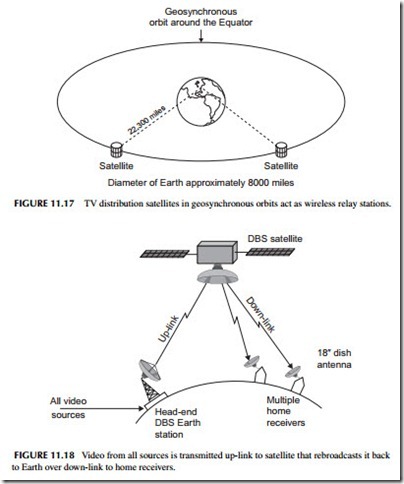SATELLITE TV
Satellite TV technically is also over-the-air TV or radio, but instead of the signals coming from one or more local TV stations, broadcast towers, the signals emanate from a geosynchronous satellite 22,300 miles away orbiting around the Equator (see Figure 11.17 ). The satellite transponders operate in the Ku band with frequencies of 10.95 to 14.5 GHz. This system is referred to as direct broadcast satellite (DBS).
The satellite TV company gets its TV like the cable companies, and brings it all together at a single Earth station head end where it is all collected and transmitted on an up-link to the satellite in the 14- to 14.5-GHz range (see Figure 11.18). The signals are then amplified in the satellite and rebroadcast on the down-link frequencies at 10.95 to 12.75 GHz. A high-gain antenna focuses the signals on the United States or other country of interest.
Down on Earth, satellite TV subscribers have a special receiver and antenna. These are illustrated in Figure 11.19 . The antenna is usually a small dish or parabolic reflector antenna about 18 inches in diameter. The antenna is usually a small horn. Also inside the antenna assembly is a low-noise amplifier (LNA) to boost the small signal from the satellite. This is then sent to a mixer along with a local oscillator signal to down-convert the signals into the 950- to 2100-MHz range. This signal is then routed by coax to the satellite receiver. The LNA/mixer assembly at the antenna is called a low-noise block (LNB) converter. This receiver signal processing at the antenna is necessary because the Ku band frequencies of 10.95 to 12.75 GHz are so high they would be far too greatly attenuated by the antenna coax cable to the receiver. So down- converting to the lower frequency allows coax to be used to the receiver.
The satellite receiver is like the cable box in that it is used to select the desired channel and demodulate it for the TV set. The satellite signals are all digital and transmitted in packets 147 bytes long. A satellite receiver is shown in Figure 11.20. MPEG-2 video decompression is used. The recovered signals
are then sent to a digital TV receiver, typically via an HDMI port. Or in older systems, the video and audio are remodulated on a channel 3 or 4 TV carrier and sent to an analog TV set.

